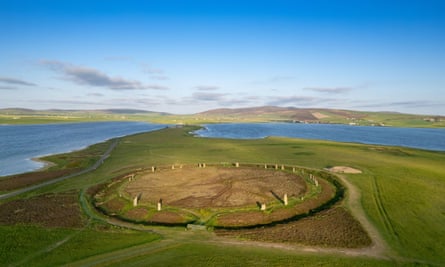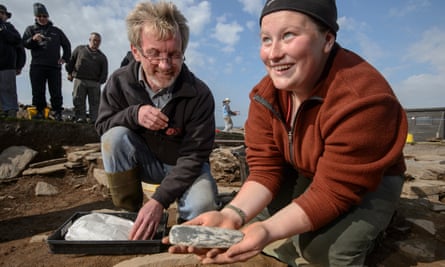In a few weeks, archaeologists will gather at the Ness of Brodgar in Orkney and for the next two months excavate at one of Europe’s greatest prehistoric sites.
For the last 20 summers, scientists and volunteers have dug here, revealing wonders that include 5,000-year-old remains of temples, hearths, a ceramic figurine, and elegant pottery.
Then, on 16 August, the team will down their trowels and brushes for the last time. Soil will be tipped over the ancient walls they have striven to uncover over the past two decades, the ground across the Ness will be returfed and the site returned, in perpetuity, to its former status: an anonymous green field.
It seems an extraordinary decision, one akin to tipping mounds of earth over Stonehenge to hide it from future generations. Nevertheless, archaeologists are adamant that this year’s dig at the Ness should be their final excavation there for the foreseeable future.
“What we have discovered is just the tip of a huge archaeological iceberg,” said Nick Card, who has directed excavations at the Ness since the site was revealed in 2003. “There are more than 100 buildings here. Underneath the most recent ones lie countless older edifices.
“We want to leave these later buildings intact. We want to avoid destroying them in order to get at those that lie underneath. So we are going to leave that task to future archaeologists who will have the benefit, we hope, of new technologies. As it is, we have amassed a vast collection of finds from the Ness that we must now study in laboratories and museums.”

The Ness lies on a promontory that separates Orkney’s two largest bodies of inland water, the Loch of Stenness and the Loch of Harray. It features a large mound that was originally thought to be made of glacial debris until a geophysical survey in 2002 suggested a far more complex composition.
Excavations began and showed that the mound was mostly manmade. The six-acre site was found to contain dozens of buildings that were linked to outhouses and kitchens by stone pavements. The bones of hundreds of cattle, elegantly made pottery and pieces of painted ceramics were found scattered round the site, remnants of a neolithic civilisation that began erecting buildings there more than 5,000 years ago.
In size and sophistication, the Ness rivals the wonders of Sutton Hoo and Hadrian’s Wall. Yet the Ness complex is thousands of years older, with excavations suggesting that the site – which is now run by the Ness of Brodgar Trust and the University of the Highlands and Islands Archaeology Institute – was, primarily, a place of gathering.
For hundreds of years, neolithic people from across Orkney and surrounding islands came here to worship, to exchange produce and to socialise. This was a place to pray, trade and party.
It was also a site of considerable influence. In the late neolithic period, the final stage of the Stone Age, around 3200 to 2500BC, a new type of pottery called grooved ware was adopted across the British Isles. “It was the first pan-British cultural phenomenon we know of – and originated in Orkney and then spread out to the rest of the country,” said Card.
“At this time, the Ness would have been known just not in Orkney but right across Britain. It was occupied for something like 60 to 70 generations. That is the same sort of timescale that separates us today from people who were alive at the Battle of Hastings. So you can see this was a place of lasting cultural importance.”
after newsletter promotion
Card added that another major factor involved in deciding to rebury the Ness lay with the stones that had been used to construct its buildings. “Unlike the resilient beach stones used to build other ancient sites on Orkney, such as Skara Brae, those at the Ness were quarried and they start to laminate and crumble when exposed to the air. So we can’t leave them exposed. We have to rebury them.”

As to the prospect of future technologies revolutionising the study of prehistoric artefacts and so allow the Ness to be reopened one day, Card pointed to techniques such as analysis of ancient DNA, which has developed significantly since 2003 and is already being exploited in a variety of different ways. For example, it is revealing how pottery was used from the food residues it absorbed.
“Drones have also transformed aerial surveys of the site – we used to fly our cameras with kites. And there is hope that in future, new types of radar and other systems can tell us what is lying below the upper layers of buildings at the Ness.”
Other work suggests that the people who built the Ness were very similar to people today – though life then was certainly not utopian: there are signs they suffered from scurvy.
“The Ness has been my life for the past 20 years,” added Card. “It has been an all-consuming experience. I have been very lucky to have been at it from the start and to see it through to the very end – though that won’t come for a very long time. Cataloguing and publishing the vast amount of finds we have uncovered is going to keep teams of us busy for years to come.”
